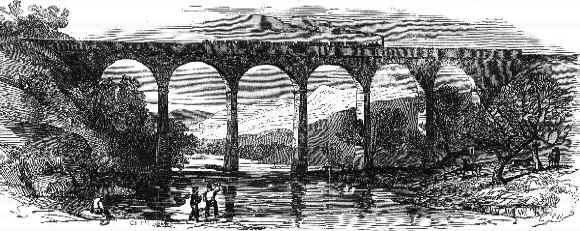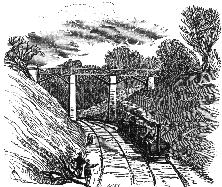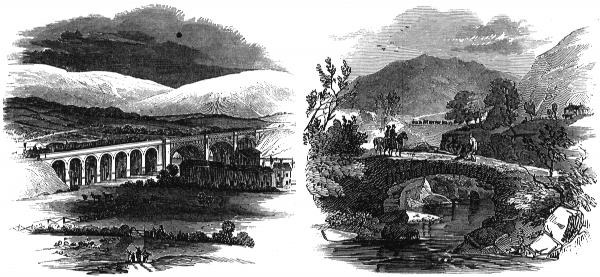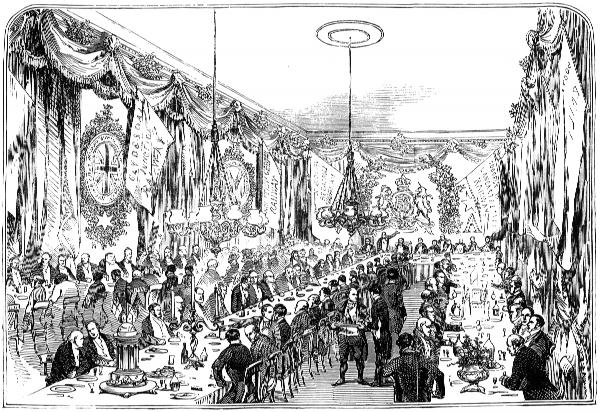OPENING OF THE LANCASTER AND CARLISLE RAILWAY, ON TUESDAY LAST Tuesday last was the day appointed for the opening of this new line of Railway.
Accordingly, the Castle Station, at Lancaster, by eleven o'clock, was a scene of unusual
bustle and excitement; and numbers of individuals, in spite of the severity of the
weather, were grouped in the old churchyard, and on the terrace of the Castle, to view the
public ceremony, by the Directors of the Lancaster and Carlisle Railway, throwing open to
the distant skies of the north those advantages which their more southern neighbours have
long enjoyed. The necessary arrangements being completed, the Directors' train, consisting
of six first-class carriages, and three second-class carriages, moved slowly from the
Castle Station, across two high embankments, to the Lune Viaduct, a work of extreme
difficulty, consisting of eight stone and brick arches, of fifty-three feet span. As a
specimen of strength and lightness, this structure is not surpassed on the Line; and its
three laminated timber arches give it a highly ornamental appearance from the town: the
whole was completed in about twelve months.
Hest Bank comes next, a small bathing village on the borders of Morecambe Bay, which lies on a wide expanse of sandy desert for many a mile, bounded by the hills of Westmorland. The train then proceeded at a more rapid rate through some deep cuttings, past Carnforth and Holme Stations, to Milnthorp Station, along an embankment of great length. This station is very substantial, and will be the best, in point of accommodation, on the Line. Beyond Sedgwick, after passing an embankment, and through some heavy rock cutting, the train stopped at Oxenholme Station, within two miles of Kendal, at the junction of the Kendal and Windermere Railways. A fine view of the town of Kendal was enjoyed from this station: the winter sun lit up the church spires, and blue roofs of the white houses which lay in the vale beneath; whilst, far beyond, rose the white-capped mountains of the West - the giants of the Lake. After a few minutes' delay, the whistle of the engine gave notice of starting; and the precaution was here taken of sending a pilot engine a few hundred yards a head. For the next mile or two, occasional glimpses were obtained of the town of Kendal, and its old Castle; the train then passed round Hay Fell, and away over Docker Garths Viaduct, commonly called Fiddler's Gill, a work of beauty and great-ness (the middle arch being about 80 feet high); and then, past Lowgill Station, over an embankment 90 feet high, to the proposed junction of the North Western Railway; and onward, round the base of Dillicar Fell, at an elevation of 200 feet from the river, which lies at the foot of the embankment; a large amphitheatre of hills rises on every side, and the path seems at an end; but the skill of the Engineers (Messrs. Locke and Errington) carried this line over many a place deemed impracticable - round the foot of hills, across rivers, over vallies, &c. Crossing Brown Beck by a Viaduct of red freestone, and the river Berbeck by another
large viaduct, the rise to the summit at Shap commences. The cutting here is the deepest,
hardest, and most expensive on the line, and varies from 50 to 61 feet in depth. The works
were first commenced here in june, 1844. The summit at Shap is 900 feet above the level of
the sea. Around, is a region of bare hills and cheerless scenes, making quick travelling a
comfort. But Clifton Moor Station is passed, and the train passes over the river Lowther,
by the Lowther Viaduct, a noble work, and next in importance to, the bridge across the
Lune.
It is unrivalled for boldness and beauty of proportion; and consists of 7 semi-circular arches of 60 feet span, supported on piers, 8 feet in thickness at the top, and increasing to 18 feet 6 inches at the base. Its total length is about 500 feet. The scenery here is a perfect contrast to the region passed. Lowther Park, with its thick and massive Woods - the clear winding river, 100 feet below - the stern grandeur of the distant mountains, just tinted with the last farewell rays of the setting sun - formed a beautiful picture. A short mile from here is Eamont Viaduct, crossing the dark and wooded banks of the Eamont, with five arches of 50 feet span each, and 70 feet high.
An embankment beyond commands a fine view of Brougham Hall, the residence of Lord Brougham; its stately park and large pleasure-grounds looked gloomily with their winter's clothing. At Penrith, the train was met by another from Carlisle; and, after gazing for a short time at the ruins of its old Castle, they each proceeded onward to Carlisle. The county, for some miles, is flat and uninteresting, with the exception of Borrock Lodge, which stands on the borders of a vale of remarkable loveliness. A high embankment passes Wreay Hall and village, noted for the beauty of its Chapel. Further on is Newbiggin Bridge - a neat wooden erection, built for the convenience of the proprietor of Newbiggin Hall, H. A. Aglionby, Esq.
They were accompanied by Mr. T. C. Heysham, Mr. P. Dixon, Mr. Steel, of the Carlisle journal, Mr. Larmer, Resident Engineer, Mr. Collister, Resident Engineer of the Caledonian Railway, Mr. Mould, Mr. Hemberow, Mr. Green and two or three other gentlemen connected with the works. The train consisted of the engine, tender, and three carriages. It proceeded at the rate of upwards of 30 miles an hour, and would have reached Penrith (18 miles) in about 35 minutes, but for a slight accident when about two miles from that place. It caused a delay, however, of upwards of an hour, when the train again proceeded on its way -reaching Lancaster (70 miles) in about three hours of actual travelling - the Directors having stopped at several places to inspect the works. In the evening, the Directors, engineers, and friends, dined together at the King's Arms Inn, and next morning, were joined at breakfast by Captain Coddington, the Government Inspector, who had just arrived from London. A little after eight o'clock, they started with a train of four carriages on the return to Carlisle. The day was excessively cold, with rain, sleet, snow, and frost, by turns. At times, the rails presented the appearance of long lines of ice, and were extremely slippery. The difficulty on such a day was the ascent of the great incline on Shap Fells, one of the severest gradients on any railway in England: the whole party watched this with no little interest; and it must have been highly satisfactory to both Engineers and Directors, when Captain Coddington, who stood upon the engine and timed its progress, announced that the ascent had been made, notwithstanding the unfavourable state of the rails, at the rate of 20 miles an hour - although the engine was an old one, and not of the most powerful class. All the heavy works - the bridges, viaducts, cuttings, and embankments - were minutely inspected by Captain Coddington, who expressed himself, at the end of the journey, as highly pleased with the whole of the works, declaring that the public might travel upon the Line with the most perfect safety; and, immediately afterwards, gave the Directors a certificate to that effect. We may mention here, that the Line is double throughout, with the exception of about two miles, near Lowther. This portion will be made double in a month, or less. The Line is remarkably easy nearly throughout - the exception being a short distance where it has been recently ballasted; and it passes through a country which can scarcely be surpassed for picturesque beauty and wildness of scenery.
Leaving the summit, we enter a cutting through limestone rock, and before it approaches Shap Village, the Line runs through a circle of large boulder stones, said to be the inner circle of an ancient Druidical Temple. The Line now proceeds on the east side of the town of Shap, along a heavy cutting through limestone rock, and passing under an elegant skew-bridge, erected at an angle of 45 degrees. The Line next descends along the flat portion of the Line called Shap Mines; and following the valley of the stream, the Line again runs under the turnpike-road; and thence passing Thrimby, through a thick plantation. Here the character of the scenery is considerably altered - the bare, rugged, and sterile mountains being succeeded by fertile pastures and picturesque prospects. The Kendal turnpike-road is crossed for the last time, by a skew-bridge at Clifton, near the entrance to Lowther Park, in which, hidden by a forest of huge oaks, stands Lowther Castle, the seat of the Earl of Lonsdale. The scenery between Shap and Clifton is very attractive - Cross Fell, Saddle-back, Skiddaw, and the other hills in the Lake District, appearing to great advantage. We are now carried along the Lowther Embankment, and about 50 miles from Lancaster and 20 miles from Carlisle we cross the river Lowther on a magnificent viaduct, 100 feet above the stream. Its arches, six in number, are of 60 feet span each; its total length, 500 feet. It is the largest and one of the most beautiful objects of art on the Line. A mile and a half from the Lowther Viaduct, the Line crosses the Eamont on a viaduct of great beauty, consisting of Five semi-circular arches of 50 feet span each. Its height is 70 feet, and its extreme length upwards of 300 feet. Westmoreland is now left in the rear, and we enter "Canny Cumberland," - the two counties being divided by the stream which we have just crossed. We immediately enter a large cutting, containing 180,000 cubic yards, and the Line then runs nearly level to the town of Penrith: the Station closely adjoining ruins of the ancient Castle. From Penrith, the Line enters the valley of the Petteril, through which it pursues almost a direct course to Carlisle, joining the Newcastle and Carlisle Railway at the London-road Station, where the line is 36 feet above the level at Morecambe Bay, and 852 feet below the Shap summit. Besides the principal viaducts enumerated, the works on the Line comprise 15 turnpike-road bridges, 64 occupation-road bridges, 86 occupation bridges, 47 cattle creeps, and 60 level crossings. We have abridged this outline from the Carlisle journal. We add a few engineering details: - Total quantity of gunpowder used upon the works - 4133 barrels, of 100 Ibs each, or 184
tons. THE CONTRACTORS' DINNER We have engraved one of the festal commemorations of the Opening of the Railway - viz., the sumptuous Dinner given by the Contractors, Messrs. Stephenson, Mackenzie, and Co. The entertainment took place in the Assembly Room of the Crown and Mitre Inn and Coffee House. This beautiful apartment was elaborately embellished for the occasion. At the upper end of the room, behind the President's chair, was displayed a mantle of white silk, emblazoned with the Royal arms, and arched with laurel and flowers. On each side appeared an illumination, the initials "V.A.," and surmounted by the order of the Star and Garter, within wreaths of evergreen. Against the wall, at the lower end of the room, was displayed an elegant flag, emblazoned with the incorporated arms of the towns of Lancaster and Carlisle, typical of the union of these two important towns by railway. Against the walls, on each side, were ranged silk flags bearing the titles of all the Railways for which Messrs. Stephenson, Mackenzie, and Brassey are Contractors, about a dozen in number,and constituting in the aggregate upwards of 800 miles of railway communication. In addition to these decorations, appeared a number of other devices, illuminated by Royal crowns, stars, &c.; wreaths of evergreens gemmed with roses, and inclosing loyal and other mottoes. With the lustre of the illuminations, aided by the light of three chandeliers depending from the ceiling, the room presented a most brilliant appearance. The dinner, supplied by Mr. Jarman and Mrs. Wells, host and hostess of the hotel, was of the most costly description. The dessert, wines, &c., were excellent. Mr. Scarisbrick, the celebrated organist of Kendal, presided at the pianoforte. The chair was occupied by John Stephenson, Esq.; G. Mould, Esq., officiating as Vice. The number of guests exceeded 200, comprising not only the heads of the various departments engaged in the construction of the Railway, from the resident engineers and contractors down-wards, but a considerable number of influential strangers interested in other lines, and many representatives of the trade of Carlisle, Kendal, Lancaster, Preston, &c. At the lower end of the room was an orchestra, occupied by an instrumental band from Cobden's establishment, Cross Hall, near Chorley, and also by a party of glee singers, chiefly from Preston, con- ducted by Mr. Edward Scarisbrick, of Carlisle. We regret that we have not space to report the very interesting after-dinner proceedings. After the customary loyal toasts had been duly honoured, the healths of the Chairman and Directors, the Engineers- in-Chief, the Secretary, and the Resident Engineers, of the Railway Company were drunk with great applause; and the toast of "Messrs. John Stephenson and Co." was received with immense cheering. Mr. Stephenson's reply modestly glanced at the difficulties which he had overcome in the construction of the Railway. He concluded by observing it was consoling and satisfactory to mark the progress of science, and he trusted that the time would come, and that ere long, when passengers could travel right through to Forfar. (Cheers.) The communication by iron rails between England and Scotland would be a great benefit to both countries; and, as an humble individual, he felt proud to, have been the means of amalgamating both sides of the Sark by the Trunk Line, part of which had yesterday been opened. (Cheers.) He could only say he felt obliged for the kindness of the Company, in speaking of him and his partners as they had done. He only regretted he could not reply adequately to their compliments, for he would repeat that he would rather make a railway than a speech any day. (Loud cheers.) Mr. Mould, Mr. Horn, and other speakers, in their addresses, entered into the details of the great work; so that the day's proceedings were stored with a vast amount of practical information, instead of the complimentary common-place which usually characterises post-prandial eloquence.
|
||||||||||||||||
|
||||||||||||||||






